skip to main |
skip to sidebar
My first ever experiment with cooking with redcurrants was redcurrant thokku. It was, despite my best efforts, still rather too sour to be used as a mix for cooked rice - according to the feedback received from my palate. The best I could do with the thokku was use it – sparingly - as a condiment with (any) dal and rice.
So, with the second of the three batches of redcurrants, as a further experiment, I made thokku with the addition of roasted tomatoes, which I usually have to hand in the fridge because roasted tomatoes make everything taste better. Need I add that “everything” is limited to whatever is made USING the roasted tomatoes? No, I thought not. (But I’ve added it anyway, in case there’s someone whose answer to that question was “Yes”. *heehee*)
This thokku was more readily palatable, with the sourness of the berries tempered by the sweetness of the roasted tomatoes. It’s as nice mixed with plain rice as any regular tomato thokku, and is also a good accompaniment for dosas, idlis and the like. The verdict from my palate, which while admitting that quality-wise this thokku is the much better improved version, also insists that it’s best had in smaller portions than regular tomato thokku. So there you have it – my palate has spoken.
Recipe for: Roasted tomato redcurrant thokku
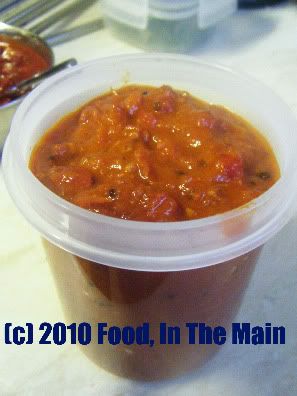
Ingredients
1-1/4 cups redcurrants, washed and drained
2 cups chopped roasted or regular tomatoes, pureed
2 tbsp oil
2-3 cloves garlic
1 tsp cumin-coriander powder
1 htsp brown/black mustard seeds
5-6 fresh curry leaves
1/4 tsp asafoetida powder
1/4 tsp turmeric powder
1 tsp sambar powder (optional)
1 tsp jaggery
1 tbsp lemon juice
3 tsp red chilli powder (or to taste)
1/4 tsp roasted fenugreek seed powder
salt to taste
Method:
1. Heat the oil, add the garlic, cumin-coriander powder, mustard seeds, curry leaves, asafoetida powder and turmeric powder. Stir for 30 seconds or so.
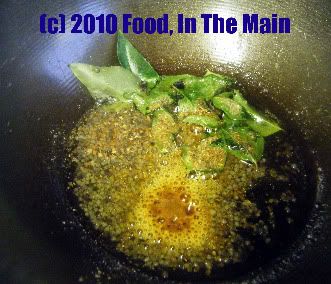
2. Add the redcurrants and red chilli powder. Mix well, cooking the berries on medium low flame until they are soft and squashed.
3. Now pour in the pureed tomatoes and mix again.
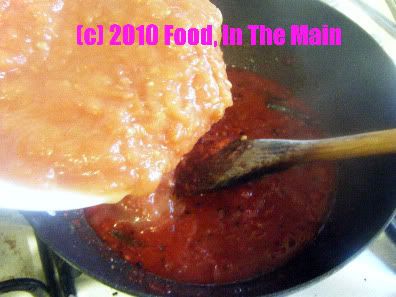
4. Bring the mixture to a boil, stirring every so often, then bring down the heat to low and let it bubble gently for 12-15 minutes, till it is thick. Add the sambar powder now, along with the jaggery and salt to taste.

Stir well. If the thokku is a bit watery, let it cook for another 5 minutes on medium heart and leave the thokku on the heat for a couple of minutes longer. There should not be any liquid in the thokku, it should be quite thick. If you like a smooth texture, puree the thokku after it cools down.
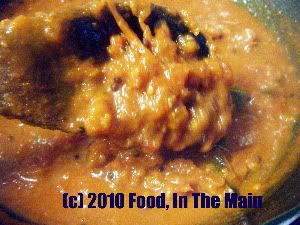
Let the thokku cool down completely before transferring to a clean jar with a tight lid. The thokku stays good for 2-3 days at room temperature. Mix with plain rice to make tomato rice with a difference, or serve as a side dish with dosas, idli etc.RECIPE: ROASTED TOMATO REDCURRANT THOKKU
Ingredients:
1-1/4 cups redcurrants, washed and drained
2 cups chopped roasted or regular tomatoes, pureed
2 tbsp oil
2-3 cloves garlic
1 tsp cumin-coriander powder
1 htsp brown/black mustard seeds
5-6 fresh curry leaves
1/4 tsp asafoetida powder
1/4 tsp turmeric powder
1 tsp sambar powder (optional)
1 tsp jaggery
1 tbsp lemon juice
3 tsp red chilli powder (or to taste)
1/4 tsp roasted fenugreek seed powder
salt to taste
Method:
1. Heat the oil, add the garlic, cumin-coriander powder, mustard seeds, curry leaves, asafoetida powder and turmeric powder. Stir for 30 seconds or so.
2. Add the redcurrants and red chilli powder. Mix well, cooking the berries on medium low flame until they are soft and squashed.
3. Now pour in the pureed tomatoes and mix again.
4. Bring the mixture to a boil, stirring every so often, then bring down the heat to low and let it bubble gently for 12-15 minutes, till it is thick. Add the sambar powder now, along with the jaggery and salt to taste.
Stir well. If the thokku is a bit watery, let it cook for another 5 minutes on medium heart and leave the thokku on the heat for a couple of minutes longer. There should not be any liquid in the thokku, it should be quite thick. If you like a smoother texture, puree the thokku after it has cooled down.
Let the thokku cool down completely before transferring it to a clean jar with a tight lid. The thokku stays good for 2-3 days at room temperature. Mix with plain rice to make tomato rice with a difference, or serve as a side dish with dosas, idli etc.
I don’t understand why the supermarkets start stocking their shelves with Christmas-oriented goods fully three months ahead of the actual occasion. It pisses me off extremely much, not that anyone cares. Any small enthusiasm for the festival that I might otherwise muster goes right down the drain when almost everything is advertised as “perfect as a Christmas present”. I don’t know about everybody else, but if anybody thought to give me an electric toothbrush (for example) as a Christmas present, they would very soon get it jammed up an orifice not situated in the face and not meant for toothbrushes - electric or otherwise.
About the only thing I’m pleased about with regard to Christmas-oriented goods is when the produce shelves are stocked with things that are otherwise not to be found for the remainder of the year – cranberries, chestnuts, redcurrants, etc. Last week I found redcurrants on the shelves on a two-for-one offer, so I bought two boxes on an experimental basis. I’d never tasted redcurrants nor anything made with redcurrants. I thought this would be a good time to see what they were like and what I could make.
Here’s what I discovered: Redcurrants are sour. Mouth-puckeringly sour. Even when they'reinvitingly red and ripe, they're sharp enough to shrivel your fillings. There’s no way they could turn to sweet from that tart extreme - not without artificial help, anyway. They’re the most gorgeous looking berries, though… tiny, shiny and very red, like grape-bunches of little red rubies.
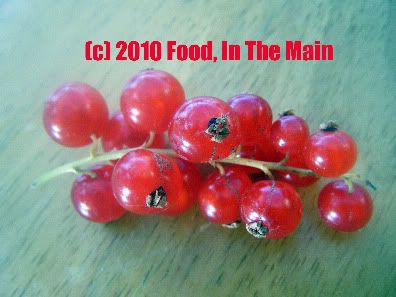
So, anyhow, eating those little rubies raw was out of the question. I googled redcurrant jam recipes and found one that combined redcurrants and strawberries. Perfect, because I had some somewhat squishily overripe strawberries in the fridge. But the recipe called for equal amounts by weight of both berries, and my strawberries were “currantly” (note the pun, note the pun!) outnumbered by about 2-1 in weight-y terms.
That was when I felt the Spirit of Enterprising Culinariness, so long dormant, take possession of me once again. (When one is possessed of this spirit, there’s nothing to do but give in to its directions.) Under its spell, I divided the berries into three more-or-less equal portions of about 1-1/4 cups. With the first portion I made redcurrant thokku/chutney. The thokku was a good use of the redcurrants, but the cooked-down berries retained so much of the tartness that the thokku had to go back on the hob for some repair-work. The ingredient quantities have been modified to reflect the “repair” so that you don’t have to cook the thokku twice like I did. But be warned, this is one sour chutney, best eaten along with dal and rice to give the meal extra zing. I ate it spread on toast, too.
Recipe for: Redcurrant thokku (chutney)
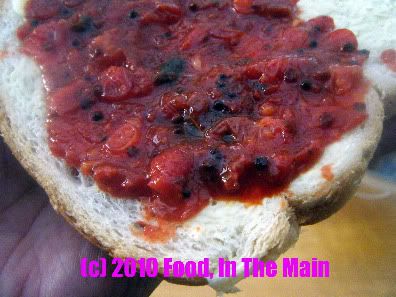
Ingredients:
1-1/4 cups redcurrants, washed and drained
2 tbsp oil
1 tsp cumin-coriander powder
1 htsp brown/black mustard seeds
5-6 fresh curry leaves
1/4 tsp asafoetida powder
1/4 tsp turmeric powder
2 tbsp sugar or jaggery
2 tsp red chilli powder
1/4 tsp roasted fenugreek seed powder
salt to taste
Method:
1. Heat the oil in a pan and add the cumin-coriander powder, curry leaves, mustard seeds and asafoetida powder.

Fry them for about a minute, till the mustard seeds pop.
2. Add the redcurrants to the pan and stir well. Let them cook for 2-3 minutes.
3. Now add the turmeric powder and red chilli powder and stir again.
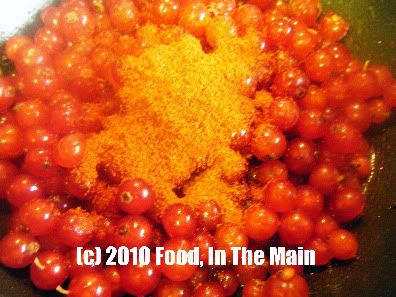
4. Let the redcurrants come to a gentle boil on medium heat, then stir in the sugar or jaggery.
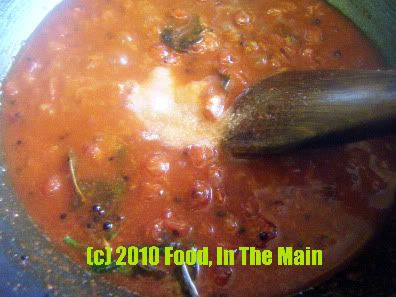
5. Let the berries cook down on a low simmer for 10-15 minutes until they lose their shape. You can mash them with a spoon.
6. Add salt to taste and finally the roasted fenugreek seed powder. Mix well. The thokku is done when the mixture becomes thick. Let it cool, then store in a tightly covered container. This stays good for 4-5 days.
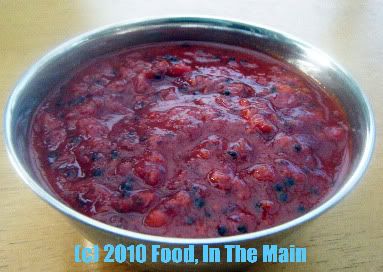
This redcurrant thokku is best used as a condiment with dal and rice.
RECIPE: REDCURRANT THOKKU (CHUTNEY)
Ingredients:
1-1/4 cups redcurrants, washed and drained
2 tbsp oil
1 tsp cumin-coriander powder
1 htsp brown/black mustard seeds
5-6 fresh curry leaves
1/4 tsp asafoetida powder
1/4 tsp turmeric powder
2 tbsp sugar or jaggery
2 tsp red chilli powder
1/4 tsp roasted fenugreek seed powder
salt to taste
Method:
1. Heat the oil in a pan and add the cumin-coriander powder, curry leaves, mustard seeds and asafoetida powder.
Fry them for about a minute, till the mustard seeds pop.
2. Add the redcurrants to the pan and stir well. Let them cook for 2-3 minutes.
3. Now add the turmeric powder and red chilli powder and stir again.
4. Let the redcurrants come to a gentle boil on medium heat, then stir in the sugar or jaggery. 5. Let the berries cook down on a low simmer for 10-15 minutes until they lose their shape. You can mash them with a spoon.
6. Add salt to taste and finally the roasted fenugreek seed powder. Mix well. The thokku is done when the mixture becomes thick. Let it cool, then store in a tightly covered container. This stays good for 4-5 days.
This redcurrant thokku is best used as a condiment with dal and rice.
Here’s a sort of Southie version of kala chana masala, cooked with tomato and onions and tamarind and sambar masala to make a tangy, spicy and really mouth-wateringly aromatic puli kuzhambu.
Yep, that’s it. No more story to this than the preceding.
And you thought I couldn’t be brief and pointful… (as opposed to pointless)
Recipe for: Kala chana puli kuzhambu
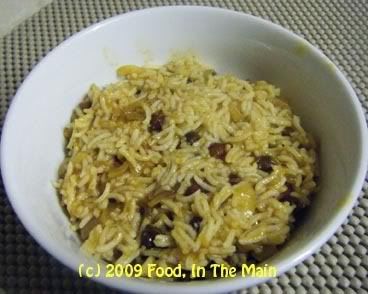
Ingredients:
1 can black chickpeas (kala chana)
1 large tomato
1 large onion
2 green chillies
pinch of asafoetida powder
1/2 tsp turmeric powder
1 tsp coriander powder
1/4 tsp roasted fenugreek powder
1 heaped tsp sambar powder
1/2 tsp red chilli powder (or to taste)
1-1/2 tsp tamarind paste
2 tsp oil
1 tbsp rice flour
2 cups water (more if reqd)
Salt to taste
1. Slice the onion, chop the tomato and vertically slit the green chillies.
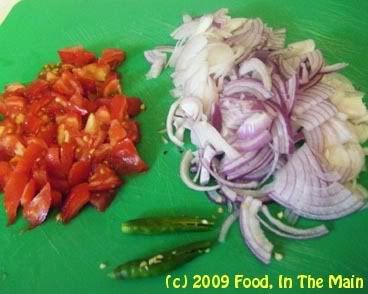
2. Dissolve the tamarind paste in 1/2 cup hot water, add the rice flour and whisk it in so that there are no lumps. Reserve.

3. Heat the oil in a pan, add the coriander powder, the asafoetida powder, the turmeric powder and the green chillies, and fry these for 30 seconds.
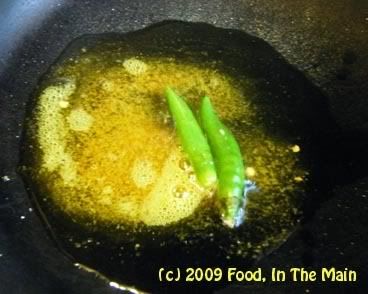
4. Add the sliced onions and stir-fry till they begin to soften.
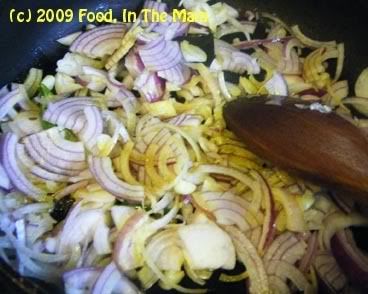
5. Add the chopped tomato now and cook it till it begins to turn mushy.
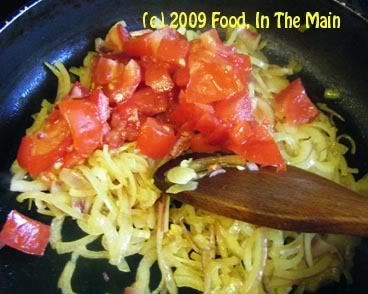
6. Next add the roasted fenugreek powder, the red chilli powder and the sambar powder and stir it all in. Fry this for 2 minutes.

7. Then add the drained black chickpeas to the pan 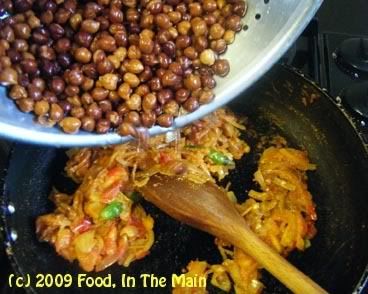
and stir for 2-3 minutes till they are coated well with the masala. 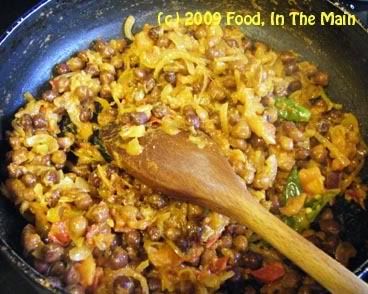
8. Pour in the tamarind water now, add another 1-1/2 cups water and salt to taste. Bring it to a bubbling boil, then reduce the heat to medium-low and simmer the kuzhambu for 10 minutes or till it comes "together" and is no longer watery. That is, it should be fairly thick.  Let the kuzhambu "rest" covered for 10 minutes, then serve it hot over cooked rice.
Let the kuzhambu "rest" covered for 10 minutes, then serve it hot over cooked rice.
The moment I read Kay's post on slow-roasted tomato thokku on her blog One Bite At A Time, I knew I would have to try it. Usually the knowing is far quicker than the making, but not this time, not when it involved tomato thokku, one of my favourite kinds of pickle. I already have a couple or three recipes for tomato thokku (plus one guest tomato thokku post)
but, as with easy-foolproof-and-perfect chocolate cake recipes, I'm always open to trying more variations.
I did a couple of things (or rather, didn't) differently from Kay's recipe, mainly because I thought I'd remembered the instructions from one reading (I didn't print it off - something I normally do - because well, the thing was to slow-roast the tomatoes in the oven. After all, how many ways could there be to nearly screw that up? um... Answer: one. Pioneered by yours truly.) Basically, I chopped the tomatoes into smallish pieces rather than quarters, and then forgot to toss them with oil before roasting.
I don’t think it made a huge difference to the taste, though the nearly-burning-it-dry factor came pretty close. Actually I added a couple of raw tomatoes to the roasted stuff while blitzing in the food processor because I didn’t want to add water just to be able to run the processor. (The fact that I had to add about 1/4 cup water to the pureed paste later, while sautéing, is neither here nor there. For some reason, despite the addition of fresh tomatoes, the puree still stayed very, very thick. If I’d had tomato juice handy, I’d have used that to thin it instead of the water. But I didn’t, so I didn’t.)
The thokku didn’t take much time to lose what little moisture I had added to the paste to make a bit more sauté-friendly. In fact, it’s the thickest tomato thokku I’ve made, and it was delightful! Roasting tomatoes in the oven is definitely the lazy cook’s miraculous answer to standing and stirring endlessly while waiting for fresh pureed tomato to lose the moisture and achieve the reduction that makes thokku what it is.
I used about three cups chopped tomatoes, and it made (more or less) about one cup cooked.
I’ll probably roast a larger quantity of tomatoes the next time I make this – and oh yes, there most definitely will be a next time. Not just for thokku either… I’m thinking that roasted tomato paste would really crank up the taste factor in other Indian dishes that require tomatoes as a base. Not to mention, pasta sauce as well. But those are ideas for other posts. For now, here’s the recipe for this one.
Recipe for: Oven-roasted tomato thokku
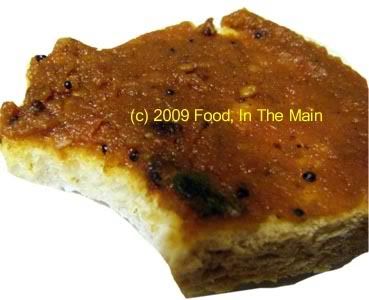
Ingredients:
4 cups chopped tomatoes (cut each tomato into thirds, then each slice horizontally and vertically to make 9 pieces)
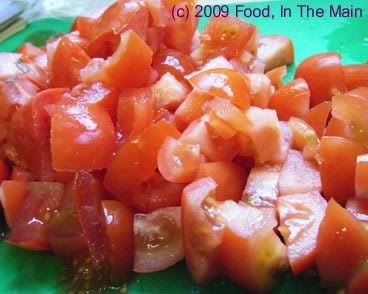
1-1/2 tsp red chilli powder OR 1 tsp red chilli powder + 1/2 tsp sambar powder
1/4 tsp toasted fenugreek seed powder
1 tsp mustard seeds
1/2 tsp turmeric powder
1/8 tsp asafoetida powder
4-5 curry leaves, torn
2 tbsp oil
Salt to taste
1/4 cup water or tomato juice (if required)
Method:
1. Place the chopped tomatoes in an oven-safe glass, ceramic or stone dish and roast for 1/2 hour at 180C,

then for up to 2 hours more at 160C. Stir once or twice in between for the tomatoes to roast evenly. There should, ideally, still be some juice left to keep the tomatoes moist for grinding.

Cool, then grind to a smooth(ish) paste using tomato juice, water or a couple of small fresh tomatoes if required. Reserve.
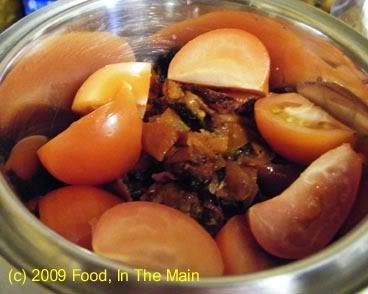
2. Heat the oil in a saute pan and add, in order, the asafoetida powder, the turmeric powder, mustard seeds and curry leaves. Stir, cover, and let the mustard seeds pop. Then add the red chilli and/or sambar powder and finally the fenugreek powder
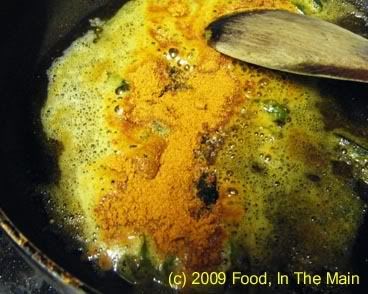
and saute for 15 seconds or so, till the powders are all amalgamated in the oil.
3. Add the ground roasted tomato paste and salt to taste, and stir it in. Add tomato juice or water as required to thin the paste, if necessary.
4. Turn the heat to medium low and let the thokku cook, stirring once or twice, till the moisture is mostly gone (about 5-7 minutes).
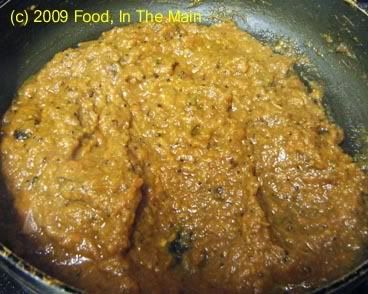
5. Cool and store the thokku in a clean glass jar in the fridge.





























